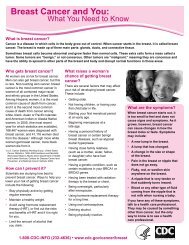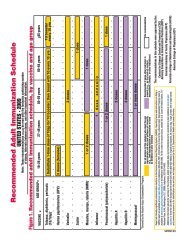Infertility Nursing - Omnia Education
Infertility Nursing - Omnia Education
Infertility Nursing - Omnia Education
Create successful ePaper yourself
Turn your PDF publications into a flip-book with our unique Google optimized e-Paper software.
tHE OMnia cME JOURnal tm | sEPtEMBER 2011<br />
to 15 days after retrieval (as a result of<br />
the hcg if pregnancy occurs). the risk<br />
of severe complications is about 4 to 12<br />
times higher if pregnancy occurs, which<br />
is why sometimes no embryo transfer is<br />
performed to reduce the possibility of<br />
this occurring. 9<br />
Early signs and symptoms of OHss<br />
include abdominal bloating, pelvic pain,<br />
weight gain of 1-2 pounds, nausea and/<br />
or vomiting, decreased urine output, and<br />
shortness of breath. Patients who are<br />
considered at risk need to be educated<br />
on the signs and symptoms as well as<br />
the potential severity of OHss. Patients<br />
should be instructed to notify their nurse<br />
or physician immediately with onset<br />
of any of these signs and symptoms.<br />
Patients at risk should be cautioned to<br />
limit their activities and increase PO<br />
fluids. Physicians, working with patients<br />
at risk for OHss, should consider low<br />
gonadotropin dose initially as well as<br />
frequent monitoring and adjustment<br />
of dosage during cycle if needed.<br />
cancelation of the insemination is<br />
sometimes the best prevention of OHss<br />
as well multiple pregnancies. iVF patients<br />
may benefit from having egg retrieval<br />
and cryopreservation of embryos.<br />
figure 1<br />
Indication for Ovulation Induction or COH<br />
WHO type I- anovulation<br />
(Hypogonadotropic hypogonadism)<br />
WHO type II - (hyperandrogenic-PCOS/<br />
Oligomenorrheic)<br />
unexplained infertility including<br />
Endometriosis I & II (no iUi)<br />
unexplained <strong>Infertility</strong> including<br />
Endometriosis I & II (with iUi)<br />
% Pregnant<br />
(per cycle)<br />
Total % Pregnant<br />
after 4 cycles<br />
29% 67%<br />
18-19% 30-58%<br />
7.7-8% 19%<br />
17.1-18% 33%<br />
Fluker et al. 1994<br />
guzick et al. 1998 &1999<br />
reassuring for patients<br />
no increased risks<br />
Miscarriage Rate: 20-25%, about equal<br />
to the general population and is age<br />
dependent.<br />
Ectopic Pregnancy Rate: 2-5%, equal<br />
to or slightly higher than the general<br />
population.<br />
congenital anomalies: the risk is equal<br />
to the general population. 10<br />
Ovarian cancer: “no convincing<br />
association was found between use of<br />
fertility drugs and risk of ovarian cancer.<br />
Furthermore, no associations were found<br />
between all four groups of fertility drugs<br />
and number of cycles of use, length of<br />
follow-up, or parity.” 11<br />
results of ovulation induction/<br />
controlled ovarian hyperstimulation<br />
with gonadotropins<br />
the results of Oi/cOH presented in<br />
figure 1 are dependant upon many<br />
factors including primary diagnosis,<br />
the woman’s age, quality of sperm, and<br />
quality of pelvic anatomy, as well as<br />
other diagnoses that may be present.<br />
the results presented below are from the<br />
literature. they are listed to provide you<br />
with an overall perspective regarding the<br />
general effectiveness of this therapy.<br />
in a retrospective review of over 450<br />
treatment cycles, Fluker et al., examines<br />
the cumulative pregnancy rates in cOH<br />
cycles in WHO group i & WHO group<br />
ii patients. 12 in another retrospective<br />
analysis of 45 published reports, guzick<br />
et al. suggests that empiric gonadotropin<br />
therapy is an effective therapy for<br />
unexplained infertility, especially when<br />
combined with iUi. 13 guzick then showed<br />
in a large randomized multicenter trial<br />
that FsH combined with iUi yielded<br />
higher cumulative pregnancy rates than<br />
FsH alone. 14 it should be noted that<br />
maternal age was a significant predictor<br />
of conception in all of these studies. 12-14<br />
Each patient should discuss their specific<br />
case with their doctor in order to<br />
determine their prognosis and potential<br />
success rates.<br />
assisted reproductive<br />
technologies (art)<br />
although, cOH/iUi results can be<br />
promising, some patients may choose to<br />
go directly to iVF following failed cc<br />
treatment to optimize their outcome.<br />
this has been demonstrated as a rational<br />
and cost effective approach by Fastt—a<br />
randomized clinical trial comparing two<br />
groups of treatment regimens, one with<br />
a “faster” approach. the first treatment<br />
group has a more traditional approach of<br />
following clomiphene/iUi treatment by<br />
cOH/iUi before moving on to iVF which<br />
is compared to a second more aggressive<br />
approach of clomiphene/iUi followed<br />
by moving directly on to iVF. the main<br />
outcome measure was the time it took to<br />
establish a pregnancy that led to a live<br />
birth and cost-effectiveness. Reindollar et<br />
al. results demonstrated an increased rate<br />
of pregnancy observed in the accelerated<br />
arm compared with the conventional arm. 15





